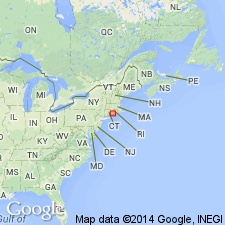
- Usage in publication:
-
- Mansfield Hollow lithofacies
- Modifications:
-
- First used
- Dominant lithology:
-
- Gneiss
- AAPG geologic province:
-
- New England province
Summary:
Hadlyme Formation of Waterford Complex here defined in the Avalon terrane of eastern CT to include three extrusive volcanic facies: North Plain, Jennings Pond, and Mansfield Hollow lithofacies. Term lithofacies, rather than member, used to convey vertical or chemical continuity, not lateral continuity. Mansfield Hollow lithofacies described as light-gray-weathering plagioclase-quartz gneiss with conspicuous layering of dark hornblende and biotite, white to cream K-feldspar, and local amphibolite. Thickness varies from about 235 m to 650 m. Crops out around the Willimantic dome and in three small outliers to the south and west. Overlies Willimantic Gneiss; upper contact cut by Willimantic fault. Unit is relatively albitic and ranges from granodioritic to tonalitic to trondhjemitic.
Source: GNU records (USGS DDS-6; Reston GNULEX).
For more information, please contact Nancy Stamm, Geologic Names Committee Secretary.
Asterisk (*) indicates published by U.S. Geological Survey authors.
"No current usage" (†) implies that a name has been abandoned or has fallen into disuse. Former usage and, if known, replacement name given in parentheses ( ).
Slash (/) indicates name conflicts with nomenclatural guidelines (CSN, 1933; ACSN, 1961, 1970; NACSN, 1983, 2005, 2021). May be explained within brackets ([ ]).

